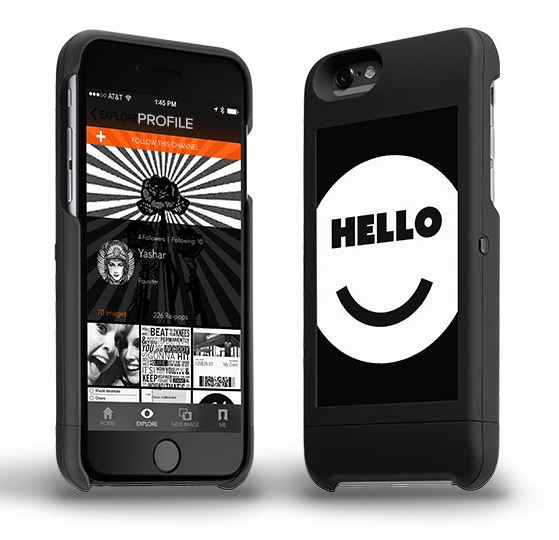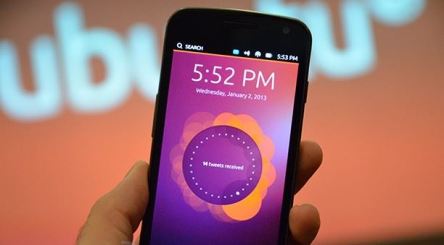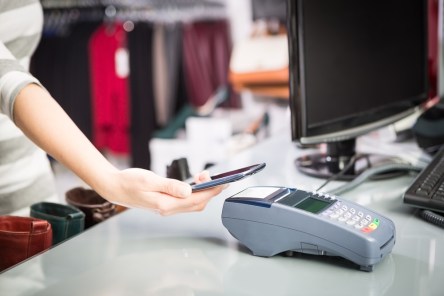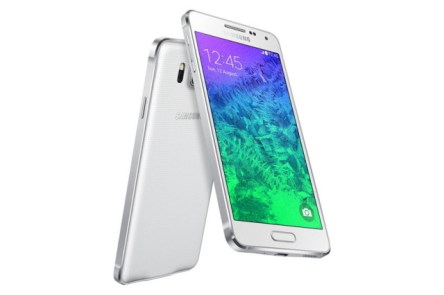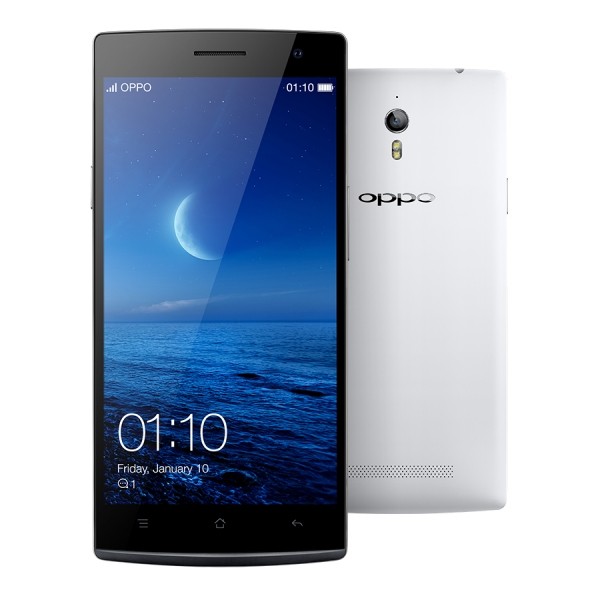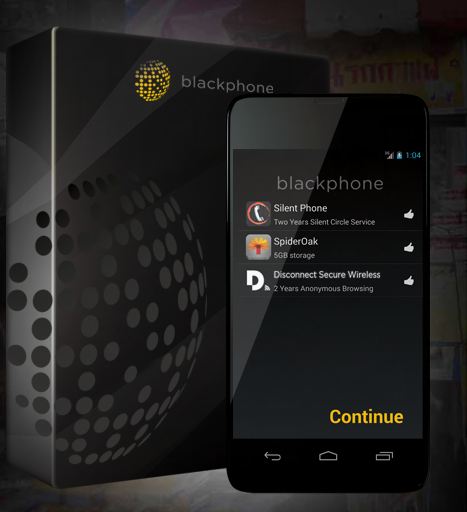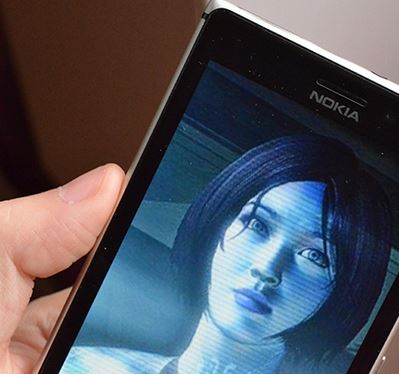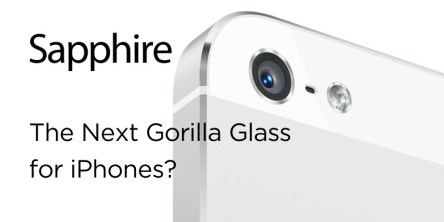Alongside the evolving smartphone industry develops another one: accessories for these can’t-live-without devices, and particularly smartphone cases. Most of them are meant to protect the smartphone in case you drop it, other are designed with a heightened sense of fashion and put vibrant colors and intricate patterns on it, some add juice to the battery life, some add protection to the holder, while others add physical keyboards for those less attracted to the touchscreens. The possibilities seem endless. Nikola Labs, an Ohio-based company, has found the way to build a case for iPhone 6 that converts RF (radio frequency) energy to DC power, in other words it pulls battery power out of thin air. Incredible? It sure sounds so, but behind this magic trick there is a scientific explanation and an issue in meeting your great expectations after reading up to this point. According to Nikola Labs co-founder Dr. Rob Lee, over 90 percent of the smartphone’s energy is lost into the environment while spending it to forge data and voice connections by using radio frequencies. Besides protection, the case has a harvesting antenna and a RF-DC power-converting rectifier circuit that through Nikola Labs’ formula can be collected and redirected to the battery life. However, this can only add about thirty percent of battery life to your iPhone 6; this is a slow process as well. On the positive side, as long as the case is connected to the smartphone, the process of collecting and reusing the wasted energy is ongoing. This translates into a slower battery depletion and not into a sudden burst of charging process. The case doesn’t have an internal battery or the capacity to store the energy, thus having a thinner figure than the already popular Mophie case. The company...
Ubuntu Phone
Universal search with Scopes
Canonical’s first Ubuntu-based smartphone has finally been released – BQ Aquaris E4.5 Ubuntu Edition is available in the European Union for €170 ($190). Chinese distribution is also underway – a date for U.S. release hasn’t yet been publicized. The technical specifications of the phone are far from exciting, especially after the much talked about Ubuntu Edge – the device that behaves like a phone until it’s plugged into a keyboard and monitor, at which point becomes a fully-fledged Ubuntu desktop. The Ubuntu Edge crowdfunding campaign failed to pique the interest of major manufacturers, but made people talk about Ubuntu Mobile. Aquaris E4.5 is a modest, mid-tier handset from Spanish manufacturer BQ, more popular for developing e-readers. The device has a 4.5-inch screen, 1GB RAM, a quad core A7 chip running up to 1.3Ghz, 8GB of on-board storage – expandable through a microSD slot, 8MP rear camera and 5MP front camera, plus a dual-SIM slot. The battery feeding the phone is a LiPo 2150mAh. Basically, it’s the same phone used by Google, but pre-loaded with Ubuntu’s mobile software. The scope of the phone is… Scopes! Here is where things become interesting. Ubuntu has created a unique platform endowed with all a mobile experience should be: seamless, effortless, uncluttered interface between user and hardware – through Scopes. Scopes represent universal search; these are a series of themed cards that compile content and which the user swipes between to navigate through the functions of the phone, with the app icons hidden to the side of the screen, or placed together on a single Scope card. The examples used refer to ‘Today’ card – it contains info such as weather and calendar, to ‘Nearby’ card – it contains location-specific local services, to ‘Music’ or ‘News’. Basically,...
Turf War
Over Mobile Payments
The battle for territory in the mobile payments sector is heating up. The ability to pay at the cash register with just the smartphone is motivating other mobile armies to take a stand, especially after Apple Pay was launched with the iPhone 6 and iPhone 6 Plus. Apple Pay proved to be easy to use; the user simply needs to hold the iPhone near the contactless reader with the finger on the Touch ID and the Near Field Communication antenna in the Apple device will do the rest. Apple Pay is secure; the company uses a Secure Element chip that encrypts user data in such a way that is preventing the company and curious eyes from getting it. The only parties that see the transaction details are the banks, credit card companies and the merchants that are directly involved in the purchase. According to Apple, a unique device number is “assigned, encrypted and securely stored” to each phone instead of the actual credit card number. Moreover, each individual transaction features a one-time dynamic security code number, too. Even though Apple Pay is limited to the users who own iPhone 6 and iPhone 6 Plus models, mobile payments have been increasing – the Business Insider research shows that “payments made through Apple Pay accounted for between 0.1%-1.6% of transactions at five top retailers in the month following the launch of the feature.” The results might seem like a small fraction, but for a brand new platform in its first month, this is actually good progress. Joining in is Google who announced partnering with Softcard, a joint venture between Verizon Wireless, AT&T and T-Mobile, to expand the reach of Google Wallet mobile payment service. In accordance with the deal, Google acquired Softcard’s technology, and the US...
GSMA Mobile World
Samsung Unpacks Six Appeal
The Mobile World Congress grows bigger every year. Over 93,000 visitors from 200 countries attended the 2015 MWC at the Fira Gran Via and Fira Montjuïc venues in Barcelona; more than 2,000 exhibiting companies showcased their latest products and services across 100,000 net square meters; more than 2,800 international media and industry analysts were present to report on everything that took place at the Congress. Some of the most exciting announcements came from Samsung, Lenovo, Microsoft, Intel, Blackberry, but they are not the only ones. Wearables were present at the event, as well as 5G connected humanoid robots and virtual reality headsets. The star of the event was undoubtedly Samsung, unpacking its newest line of flagship smartphones: the six appeal Samsung Galaxy S6 and Samsung Galaxy S6 Edge. They both have a completely redesigned look and feel, mostly due to ditching the cheap plastic for premium metal and glass; the new design feels somewhat familiar. Technical specification-wise, the two models are similar: a lightning fast 64 bit, Octa-core processor powers the devices, breaking from Qualcomm as its primary supplier for the first time since the Galaxy S2. The new processor, dubbed Exynos 7420 – CPU, is supported by a meaty 3GB RAM and 32/64/128GB internal storage, ditching the micro SD slot – this might upset a few, but probably shouldn’t as the internal storage included should suffice. Both smartphones come equipped with a 16MP back camera with optical image stabilization, autofocus, 4K video and LED flash and a 5MP, wide angle front camera with 1080p@30fps, dual video call and auto HDR. The display measures 5.1 inches with a resolution of 1440 x 2560 pixels (~577ppi pixel density), protected by the latest Corning release, the Gorilla Glass 4. The display is where the two devices differ...
Samsung Galaxy A7
Ready for the "autoselfie"?
I was browsing through images of computers, phones, and smartphones and their transformation over the course of years, when it dawned on me that not only art imitates life, but technology does, too. All of the sudden, my mind was back in the Baroque period, reminiscing the famous paintings of Flemish painter Sir Peter Paul Rubens. The term “Rubenesque” popped into my mind, terminology known by art enthusiasts to be referring to his fondness of painting plus-size women, the beauty standards of those times. And I stared at the world’s first desk computers, at the first phones, at their generous widths. How times change… today’s beauty standards got stuck somewhere at size zero. The ever-skinnier tech devices follow the trend. The latest to enter the scene of skinny devices is Samsung’s Galaxy A7, one of the company’s slimmest smartphones yet, only 6.3mm (0.245 inches) thick that weighs 141g. At first glance, its design makes you think of Apple’s iPhone 5 with its curved edges, metallic band, and silver home button surround. But you’ll soon see the Samsung in it. Samsung Galaxy A7 is attempting to please its followers and to catch the attention of Apple users as well, as “one of the slimmest Galaxy smartphones equipped with premium hardware for a superior social experience, expanding on the popular services provided by the Galaxy A5 and A3.” The hardware on the 5.5-inch smartphone, even though not Samsung’s best, is worthy of attention as it humbles the price along with the technical specifications. A7 comes equipped with two separate quad core processors – 1.8GHz and 1.3GHz or 1.5GHz and 1.0GHz for the dual-SIM version – paired with a 64-bit Qualcomm Snapdragon chip; eight cores should be snappy at handling multiple tasks. Backing up the package are...
Oppo R5
World’s slimmest smartphone
Chinese tech manufacturer Oppo Electronics presented their latest products just in time for the winter holidays, including two new phones, the N3 and the R5. The N3 will most likely be attractive to photography fans, considering the 16 megapixel camera mounted on a 206 degree rotating motorized mount; the R5 might catch the eye of the fashion conscious smartphone buyer. And something else: Oppo R5 steals its name from Gionee’s Elife S5.1 as the world’s slimmest smartphone by flaunting its 4.85mm thick steel body. How much has affected the device’s slim silhouette its specifications? – Down to a more than competent device, but not quite in the “flagship” spectrum. The smartphone sports the 64-bit Snapdragon 615 octa-core processor running at 1.5GHz next to an Adreno 330 GPU, 2GB of RAM, and 16GB of storage (no, no microSD expansion available). The battery is rather small (not surprisingly) at 2,000mAh, but it charges quickly due to the VOOC mini Rapid Charge tech support – the device can go from zero to over 75 percent in just 30 minutes. The 5.2-inch display is Full HD AMOLED (1920 x1080), 423 PPI. The frame of the phone is made of 3D-welded hand-polished aluminum alloy, and without too much width to match the lack of depth, the weight is down to 155g. The stunning Oppo R5 sees through a 13-megapixel Sony Exmor main camera and a 5-megapixel front-facing 83 degree wide angle front camera with f/2.0 for both. Scene modes feature Ultra-HD, Colorful Night, Slow Shutter, Expert Mode, Beautify, HDR, Panorama, Audio Photo, GIF, Double Exposure, Raw, Super Macro, and After Focus. Other features include 4K video at 40fps, 1080p video at 60fps, and 720p slow motion video at 120fps. The issue of camera optics has been dealt with by...
Wi-Fi Calling
Gaining traction
Wi-Fi Calling has never been a priority for carriers with good cellular service. However, following the recent announcement that iPhones will support Wi-Fi Calling through iOS8, and that T-Mobile is already on board, the rest of the carriers have somewhat been forced to rethink their plans for this service. The terminology might be confusing, what does Wi-Fi Calling mean exactly? This nifty sounding technology uses your home Wi-Fi to make calls and send texts over the internet. It allows cellular packets from your phone to be transferred to your carrier over the internet, and reintroduces them into the cellular network, much like beaming over the air. It differs from Google Hangouts and Skype – these let you talk to other people by using call forwarding or some internet-based interface – Wi-Fi Calling allows you to use your actual carrier phone number over the internet. It differs from VoIP technology which lets you use an internet-connected phone just as you’d use a landline, transferring your voice over the internet to the switched telephone network – the Wi-Fi Calling technology drops the cell towers path, connecting your voice to your mobile carrier’s network using the internet. One of the advantages of this system is that it can help you conserve plan minutes and texts, as the calls that are made over Wi-Fi don’t count against your plan. Moreover, it enables you to make calls using your phone number even when your network cuts out or when you’re outside your coverage area. Wi-Fi Calling is not a new idea – smaller providers like Republic Wireless have been offering the service for quite some time – but Apple’s announcement may be forcing everyone by emphasizing the technology and launching it before the rest are ready to go. At...
The New Black
Secure phones, ultimate privacy
The world is realizing more of the gadgetry from James Bond’s reality, and it’s about time. But we’re not talking about underwater jet packs or a BMW equipped with missiles. Secure phones that ensure secret-agent level privacy are in demand across consumer sectors. They’re even being made by military contractors. Boeing has unveiled a secure smartphone that marks a unique departure for the Chicago-based aerospace and defense company, best known for making jetliners. In order to accomplish defense and security missions, security and flexibility are key factors, and their smartphone is primarily aimed at government agencies and contractors who need to keep their data secure. Made in the United States after 36 months of development-stage, the Boeing Black Smartphone features a 4.3-inch qHD (540 x 960) pixels handset with dual SIM cards, to enable it to access multiple cell networks. The battery stops at 1590 mAh, and has Bluetooth v2.1 + EDR-enabled connectivity. It runs on Android OS and its key features include disk encryption designed to store sensitive information securely, hardware Root of Trust to ensure software authenticity, a Hardware Crypto Engine to protect stored and transmitted data, Embedded Secure Components to enable trusted operations, Trusted Platform Modules to provide secure key storage, Secure Boot to maintain device image integrity, and “hardware modularity” for multiple modularity capabilities. However, the central security feature of the Boeing Black is the PureSecure, an architectural foundation “built upon layers of trust from embedded hardware, operating system policy controls and compatibility with leading mobile-device management systems.” In addition to all these, the smartphone includes the ability to communicate via satellite transceivers and “discrete radio channels”, advanced location tracking and biometric sensors. But what takes this mobile device to another level is that on top of the call encryption...
Introducing Cortana
Microsoft's voice assistant
Microsoft needs to take bold steps to regain precious ground. To that end, its Build 2014 Developer’s Conference included news both expected and surprising. The expected announcements were related to the new Windows Phone 8.1 software and the much-anticipated update to the Windows 8.1 OS. The surprise was the new Windows 7-style Start menu for Windows 8, which will be launched as a free update. The main focus of the conference reflected Microsoft’s path of offering the ability to experience the same look and feel of applications across phones, tablets, and PCs, as well as the ability for the developers to easily build apps for all three platforms. “I am absorbing the Internet… now I’m learning about you.” The spotlight of the keynote was on Cortana for Windows Phone 8.1, the upcoming voice assistant that has the task of competing with Apple’s Siri and Google’s Google Now. Even though right now the new sassy digital assistant is a beta app, there are a few interesting things about her – she’s talkative, but knows what she’s talking about as she’s been given the ability to mine the Windows Phone content (with the user’s permission) and also search the web. “Because she’s powered by the Internet, you could say that she knows everything about the world,” Joe Belfiore said. “But because she runs on your Windows Phone, she also knows everything about you.” Cortana will have her own Live Tile, at the same time replacing the search function on the Windows Phone. She can take notes, send reminders, set alarms, and recognize the places you frequently visit. She also has a “Notebook” where she tracks certain user interests, including an “inner circle” of favorite users. The “Quiet hours” feature blocked notifications, with permission to reach you...
Sapphire Glass
Powered by the sun
Apple’s highly-anticipated sapphire glass will not only offer super-protection to our favorite electronic devices, but will also improve battery life by the addition of solar-powered charging cells. Sapphire is one of the three gem-varieties of corundum, the other two being ruby – corundum in a shade of red – and padparadscha – a pinkish-orange. Although blue is the most common color, corundum can also be colorless or pink, green, and shades of gray and black. It can be mined or artificially produced. Sapphire is more than a beautiful and extremely expensive gem. Because of its remarkable hardness – 9 on the Mohs scale, right after the diamond which scores the maximum 10 – sapphires are used in non-ornamental tasks such as infrared optical components (red ruby sapphires are utilized to create new-infrared lasers due to their capacity to be turned to the appropriate wavelengths, because of the titanium and chromium impurities that form them), high durability windows for high pressure diagnostic and scientific equipment, including bullet proof glass, wristwatch crystals and movement bearings, and scratch-resistant coverings for lenses and high-end watch faces (Rolex, Citizen, etc.) It is important to note that Corning Gorilla Glass scores ~7 on the Mohs scale. Very high-end smartphones are already using sapphire crystal screens. The handmade Vertu Ti has a 3.7-inch crystal-covered screen, but thus far the technology has been too expensive for mass produced smartphone screens. Apple started using it to protect the cameras on the iPhone and, more recently, on the home button for the 5S model. But things are not about to stop here. In a post on the Seeking Alpha investor blog, Matt Margolis concludes that the $578m deal Apple struck with GT Advanced Technologies has more than just the sapphire glass growth initiative behind...
Incentives to Upgrade...
New Plans Encourage Changeouts
I’m always curious to discover what innovations manufacturers have brought to the market when they announce new smartphone devices. Fortunately for my budget, I can’t purchase all those that make my eyebrows rise. Like most, I am on a standard payment plan that limits me to upgrade every two years. However, smartphones have hit a level where innovation has slowed down. At this point, they all flaunt beautiful screens and high-quality cameras. The new models don’t differ drastically from their previous versions, and this decreases the urge to purchase newer ones more frequently. Fewer and fewer consumers are upgrading year after year. Obviously, this is not so good for the business and the big players in the US know it, so they decided it was time they took action. First it was T-Mobile USA who announced their new plan called T-Mobile Jump. It entails an upfront payment for a smartphone followed by a period of monthly payments. This action can be done twice a year and the down payment amount is quite decent – $146 for an iPhone 5. AT&T followed with their AT&T Next, a plan that encourages customers to upgrade their phone once a year instead of every two years. They’re proposal is more of a phone rental than a phone purchase – there will be no upfront payment, just monthly installments for a year that vary based on the device. In the case of “renting” an iPhone 5, the customer would pay zero upfront, followed by $32.50 every month for a year. Once the period is over, the customer can upgrade to a new smartphone. Verizon is said to be coming out with the VZ Edge, a plan that supposedly allows the users to upgrade their phone once they’ve paid off...

